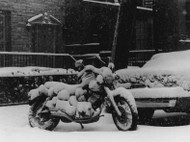Motorcycle Winterizing Guide
Posted by Cameron Barrie on 6th Dec 2024
As few of us are lucky enough to live in a part of the country that allows year-round riding, every year brings that dreaded moment where your bike must settle down for its beauty sleep. This time, make sure you give it the bedtime routine it deserves by following our comprehensive winterizing guide!
Thoroughly clean and dry your bike.
Yes, nobody but you is going to see it for the next three months, but the last thing you want is for it to emerge from hibernation with rust spots and pitted paint. We just plain believe in washing your vehicles – it’s a good opportunity to give them a once-over and ensure everything is in its right place.
Wrap up any outstanding major projects.
This may matter less for bikes that will ride out the season in a pristine climate-controlled garage, but leaving a bike in pieces for the winter with a project half-finished is a surefire way to forget what you were doing and lose your momentum (or your parts).
Get that gas good to go.
There are two major schools of thought for winterizing a fuel tank: drain completely or fill to the top and treat. Your primary enemy is condensation on the inside of the tank, and both strategies are intended to minimize the possibility of water left inside causing rust. When draining the tank, open petcocks fully and get every last drop of fuel out before spraying the inside with a moisture displacer such as WD-40. Here, compressed air is great for atomizing the lubricant and ensuring it coats and protects all interior surfaces.
When filling the tank for the winter, pick up a fuel stabilizer like Helix or Ethanol Shield. These products are designed to prevent the effects of moisture and cold temperatures on fuel that will be sitting for an extended period of time. Here’s a good trick to ensure it gets fully mixed and runs through the fuel system: wait until your tank is as close to empty as possible, ride to your nearest gas station, and add the stabilizer before filling all the way up with as low-ethanol gas as you can get.
Tend to that battery.
When sitting for long periods of time, batteries can discharge on their own, and cold temperatures can exacerbate this effect. Keep your bike on a trickle charger (like a Battery Tender or Optimate) for the winter to avoid a loss of voltage and potential damage. Depending on the type of battery you have, you may need a specific type of charger. Some are designed explicitly for lead-acid and will not work with lithium-ion (and vice versa), so double-check your equipment.
Plug holes.
Unless your bike spends its winters in a maximum-security, hermetically-sealed subterranean vault, critters of all shapes and sizes can and will try to make it their temporary home. Take care to plug up any small holes, nooks, and crannies that might scream “free real estate”. The last thing you want is to discover a nest of chewed-up wiring harness and insulation come springtime. This goes double for anyone storing their bike outside for the winter!
Elevate off the concrete floor.
Common choices for garage floors, solid concrete and cement are actually quite porous and can pull moisture from anything resting on them for long periods of time. Cold temperatures can also wreak havoc on tire rubber compounds. Spare yourself from the dreaded dry rot by properly inflating your tires prior to storage and placing a barrier between your bike and the ground. A motorcycle stand, plywood, carpet, or even cardboard can go a long way to keep them in good condition.
Cover!
For outside bikes, a solid cover should be at the top of your checklist. This humble barrier can do a great job at keeping out the harsh elements, and if you can only be bothered to do one thing for the winter, this is it. If you haven’t replaced yours recently and can see some daylight through the holes, it might be time to invest in a new one. Nelson Rigg has some great offerings, such as their Defender and Defender Extreme series.
Avoid starting it up.
Unless your area is blessed with an extended period of nice weather, avoid starting your bike for short amounts of time. Contrary to popular belief, the practice of regularly starting it up for a few minutes can actually cause more harm than good. Allowing the engine to run for a limited amount of time can cause condensation to build up in the fuel system and drain the battery without allowing it to reach the RPMs necessary to recharge and maintain its normal voltage. When done repeatedly in cold weather, the detrimental effects of a short start can quickly stack up.
Whatever your method of choice, do the right thing and give your bike some thought ahead of this winter season. By following our winterizing tips, you can be confident that your ride remains in top condition through the long winter. With just a little care and attention, your bike will be ready to hit the open road as soon as the weather warms up.


